Indonesia: Java, Bali, and Komodo Islands - September 10 - October 2, 2017
Part One - Java
Page One - Jakarta, the capital city
I went on an Overseas Adventure Travel trip to Indonesia.
Indonesia consists of hundreds of distinct native ethnic and linguistic groups,
with the largest—and politically dominant—ethnic group being the Javanese.
The population is unevenly spread throughout the islands with a variety of
levels of development, ranging from the megalopolis of Jakarta to
remote tribes. A shared identity has developed, defined by a national
language, ethnic diversity, religious pluralism within a Muslim-majority
population, and a history of colonialism and rebellion against it. Indonesia's
national motto, "Bhinneka Tunggal Ika" ("Unity in Diversity) articulates the
diversity that shapes the country. Situated between the Indian and Pacific Oceans, it
is the world's largest island country with more than 17,000 islands. It has an estimated population
of over 261 millions people, the world's 4th most populous country, and the most populous Muslim
majority country. Java, the world's most populous island, has more than half of Indonesia's population.
The earliest humans were probably fishermen, who were displaced by settlers known as Austronesians
about 2000 BC. From the 700s to 1000s, the major islands changed from local powers into kingdoms that
intermarried and allied with other islands, and Hinduism and Buddhism had arrived. One multi-island
kingdom was the Majapahit Empire, a Hindu empire based in Java. At its height, it covered much of
current Indonesia, Singapore, parts of Thailand and the Philippines. In the 1300s, Islam started
gaining momentum, and 2 Islamic states, sultanates, were established on Sumatra and 1 on Java.
In
about 1527 the Demak Sultanate in Java took control of Java, ending the Majapahit empire. Many
of the Majapahit elite fled to Bali, which is why Bali is still predominantly Hindu. In the 1500s, the colonial
era began, with the area dominated by colonial powers, first the Portuguese, then the Dutch, with the spice trade
bringing the Europeans to
the area. The Japanese invaded in March 1942; the United Nations estimates about
4 million Indonesians died during WWII as a result of Japanese labor camps and famine. Two days after
Japan surrended in 1945, Indonesia declared its independence. The Dutch resisted but eventually recognized
Indonesia as independent in 1949.

Evening tour around our hotel on first night in Jakarta
Vendor cutting open the fruit called durian. Our trip leader, Susi, is on the right.
There were a lot of street vendors around the hotel; some were cooking
food for customers. This is a typical part of the culture.
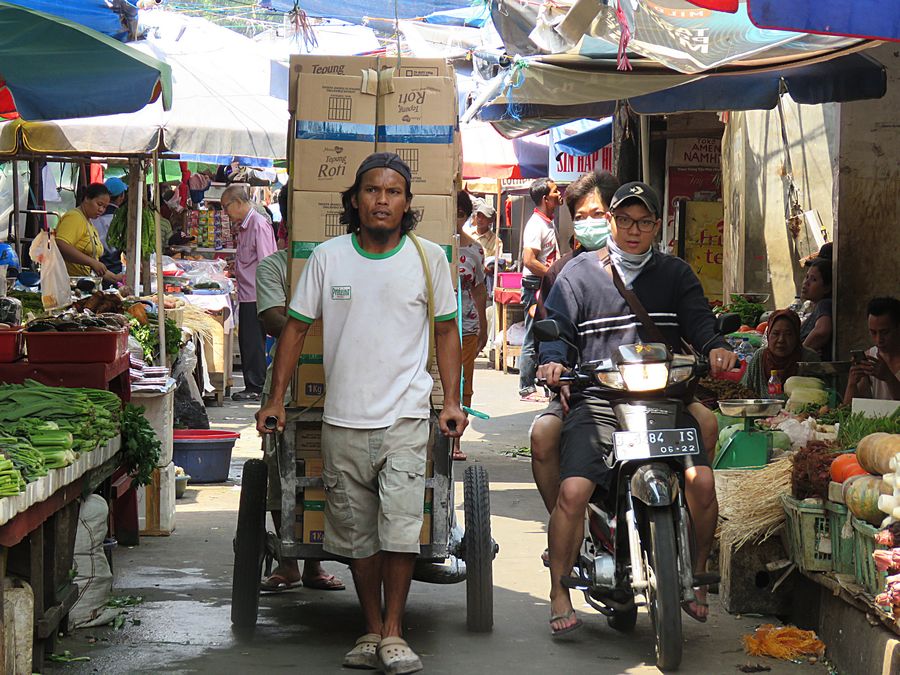
Walking through Chinese community local market area the following morning.
Motorbikes are a common form of transportation throughout the country.
Jakarta has noticeable pollution, which is probably why you see the
motorbikers with masks. in
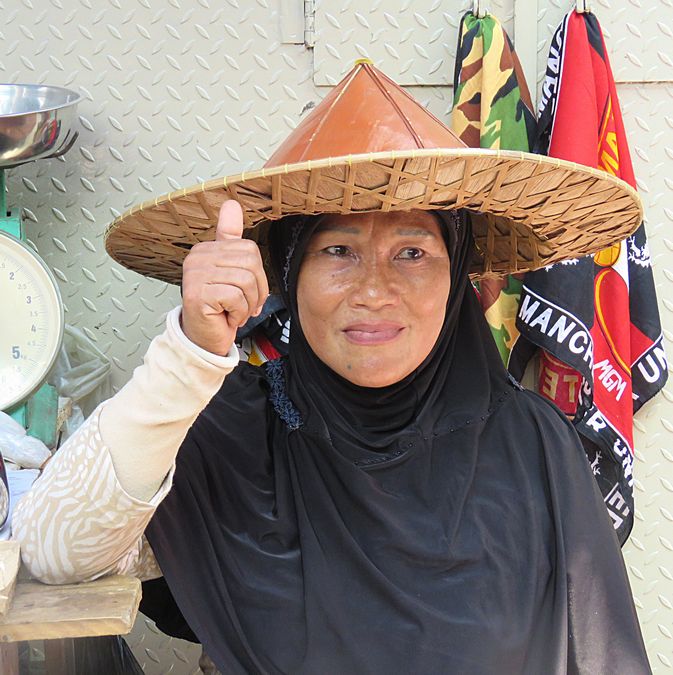
People were friendly to us wherever we went. Many gave us a thumbs up sign.
This woman is one of the vendors in the local market in the Chinese area.

A couple of the more unusual items for sale at the Chinese local market -
turtles and eel
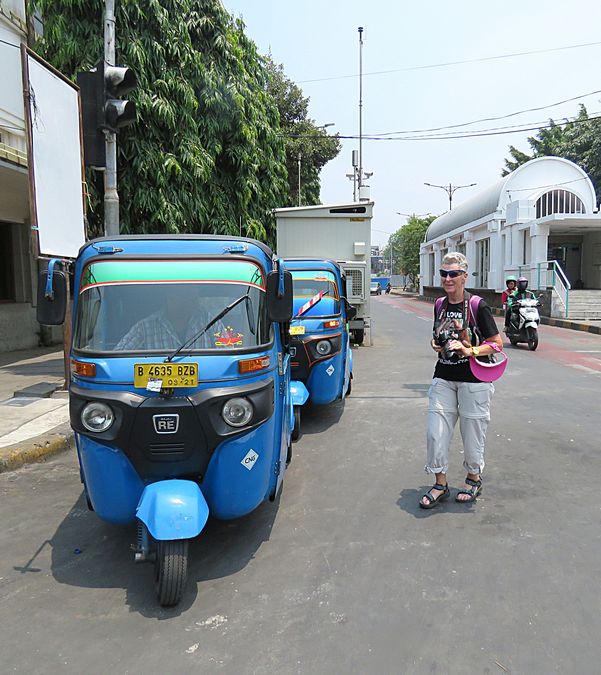
From the Chinese community in Jakarta,
we travelled by bajai, 3-wheeled vehicles, to Fatahillah Square,
former administrative and commercial heart of Dutch colonial Indonesia.

Fatahillah Square, also known as Old Batavia, is the historical district of
Jakarta. During Dutch Colonial times in the 16th century, this was the
heart of the walled city. View shows former City Hall, which is now the
History Museum.

High school kids who had an assignment to interview English
speaking foreigners. They came up to talk to us after we
exited the restaurant where we had lunch.
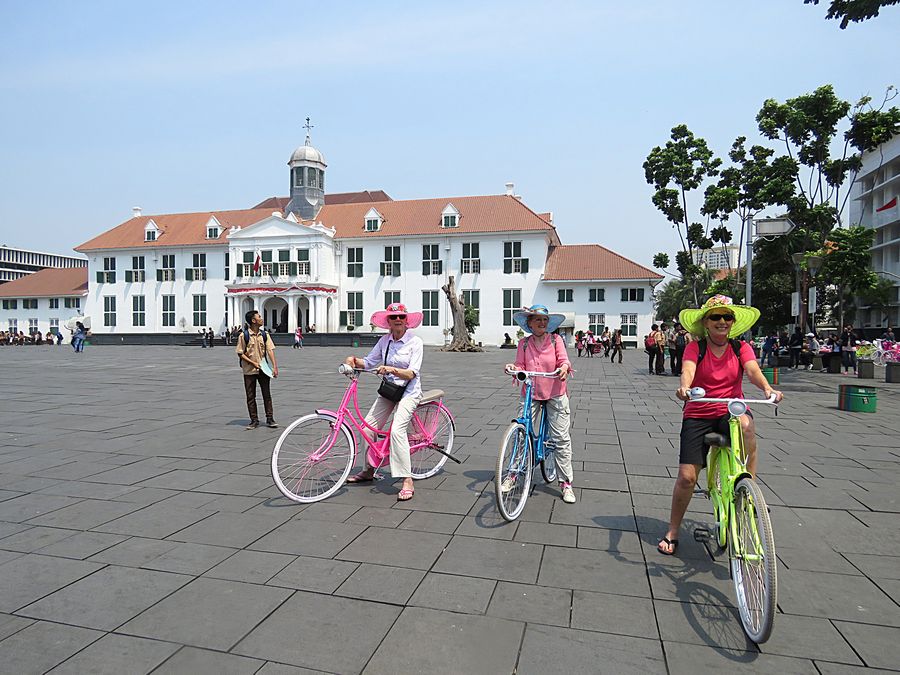
Patsy, Robin, and Dorothy from our group on bikes you can rent to ride
around the square and wearing hats you can rent with the bikes.

Cafe Batavia on the Square - where we ate lunch.
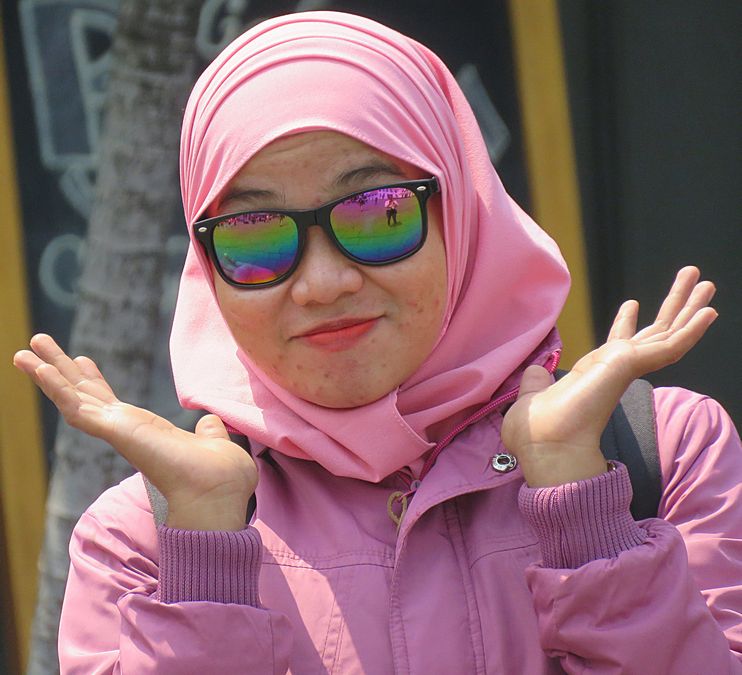
About 80 percent of the Indonesian population lives in the western parts of
the country, but that segment of the population is growing at a slower pace
than the rest of the country. There is a gap in terms of wealth,
unemployment rate, and health between the densely populated islands
like Sumatra and Java, that are the economic centers, and the sparsely
populated islands such as Maluku, and Papua. Economic inequality is an
issue that not only affects the economy,
but also the social structure, resulting in social discrimination. Racism,
especially against the Chinese since the Dutch rule, is a major and
controversial issue and still continues today.

A student looking at the photo on her phone she had taken of some of us.
Education in Indonesia is compulsory for twelve years. The constitution
dictates that 20 percent of the national budget is to be prioritized for
education. Parents can choose between state-run, non sectarian public
schools supervised by Ministry of Education and Culture or private or
semi-private religious (usually Islamic) schools supervised and financed
by the Department of Religious Affairs. Private international schools, which
are not based on the national curriculum, are also available. The enrollment
rate is 90% for primary education (2015), 76% for secondary education,
and 24% for tertiary education. The literacy rate is 95%.

Another student that I talked to.
In rural areas, there is a significant drop in school participation after
primary school due to such factors as lack of access to schools, the need
for boys to work in the fields and girls to look after younger siblings.
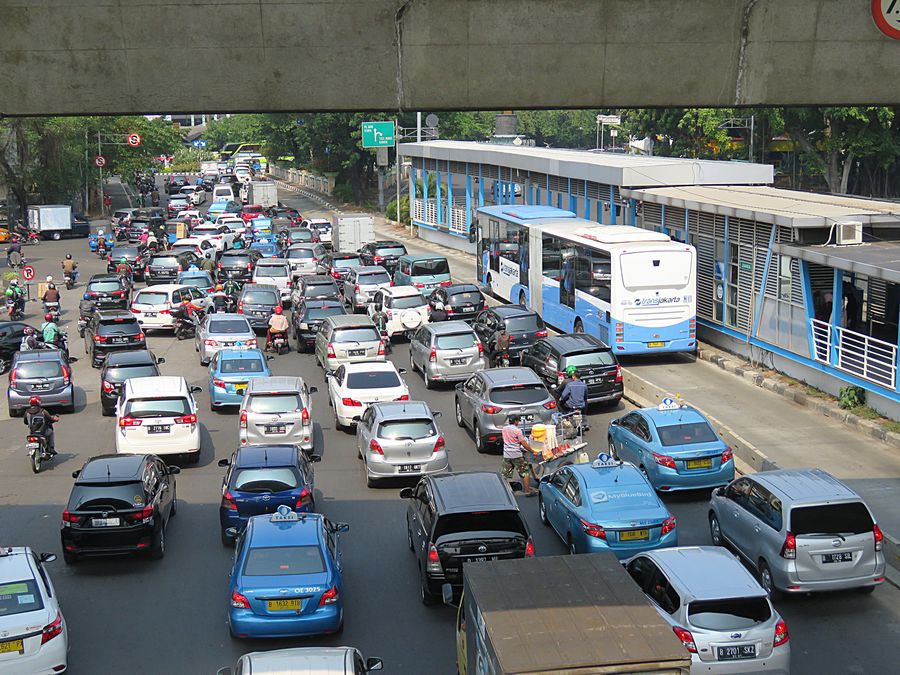
Example of typical heavy traffic congestion. No lane markings, few
crosswalks or stoplights anywhere. Pedestrians have to hold up their
arms and hope vehicles will stop to let them cross. Note the vendor who
is crossing the street with his cart, in the midst of the cars and motorbikes.
This congestion is typical in other larger cities in Indonesia as well.
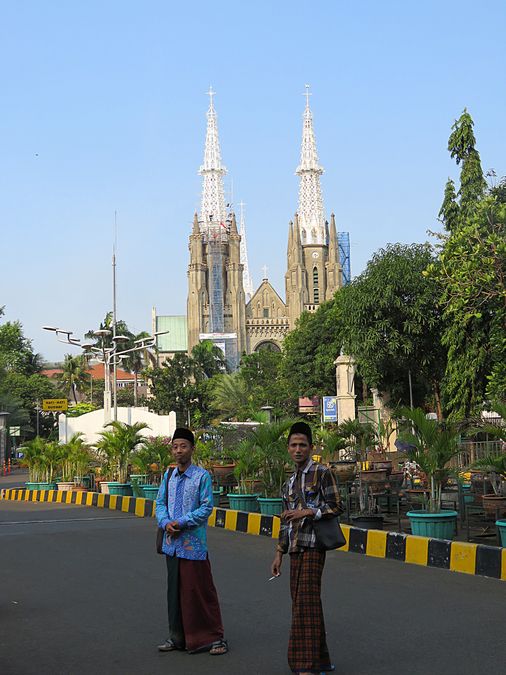
The Jakarta Cathedral,
a Roman Catholic Cathedral in Jakarta, that is the
seat
of
the Roman Catholic Archbishop of Jakarta.

Istiqlal Mosque in Jakarta, the largest mosque in southeast Asia.
It is the national mosque of Indonesia and was built to commemorate
Indonesian independence and named "Istiqlal," an Arabic word for
"independence."
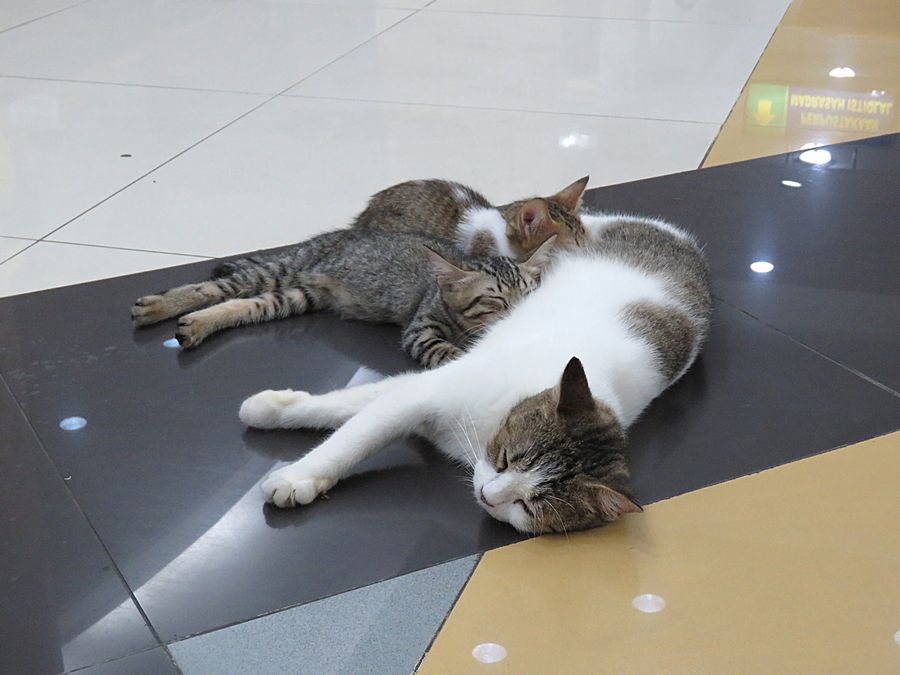
We saw a lot of stray cats in Jakarta. These cats were inside the mosque
and may not have been strays.

Inside the mosque
While religious freedom is mandated in the Indonesian constitution, the
government officially recognizes only six religions: Islam, Protestantism,
Roman Catholicism, Hinduism, Buddhism, and Confucianism. Indonesia is
the world's most populous Muslim majority country, about 205 million
adherents, with the majority being Sunni Muslims. The Shias and Ahmadis
respectively constitute 0.5% and 0.2% of the Muslim population. Christians
make up about 10% of the population (7% Protestant, 3% Roman Catholic).
1.7% are Hindu, and 0.9% are Buddhist or other. Most Indonesian Hindus are
Balinese (from Bali island), and most Buddhists in modern-day Indonesia are ethnic Chinese.
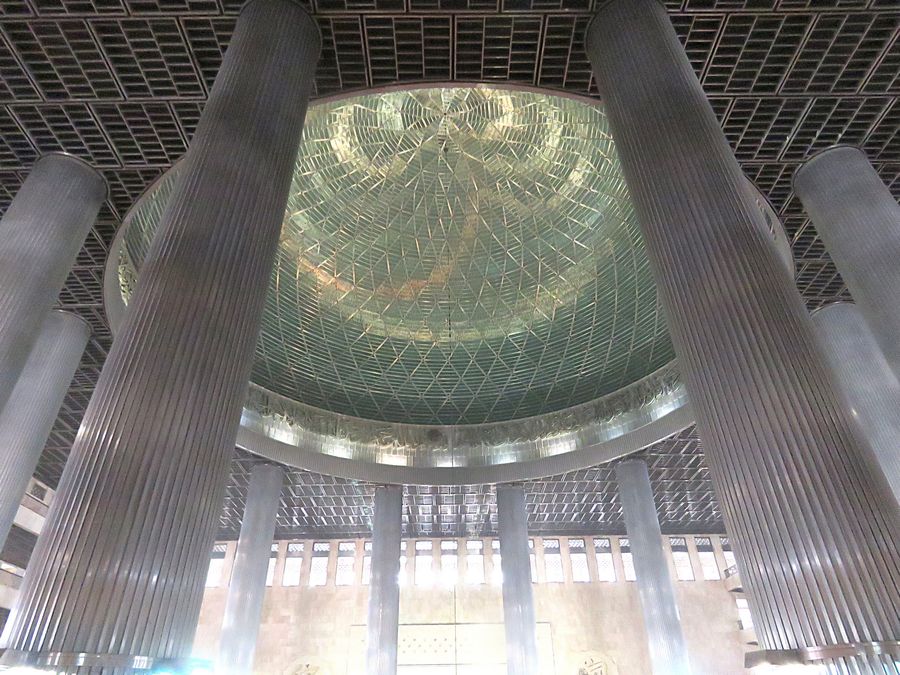
The dome inside the Mosque

Istiqlal mosque has a single minaret to symbolize the divine oneness of God.
Link to Page Two - Yogyakarta
Pat's Home Page